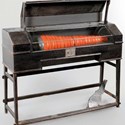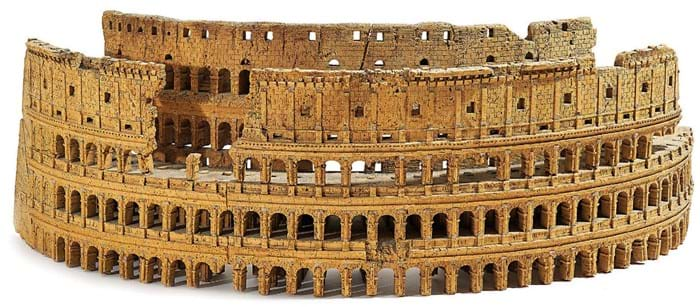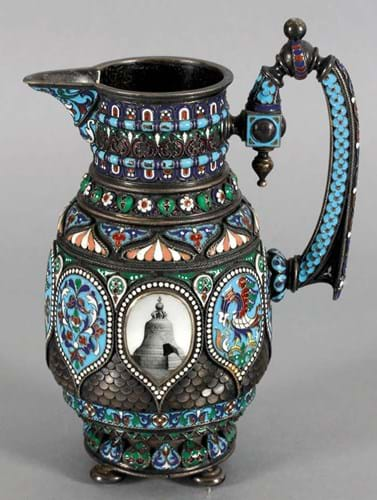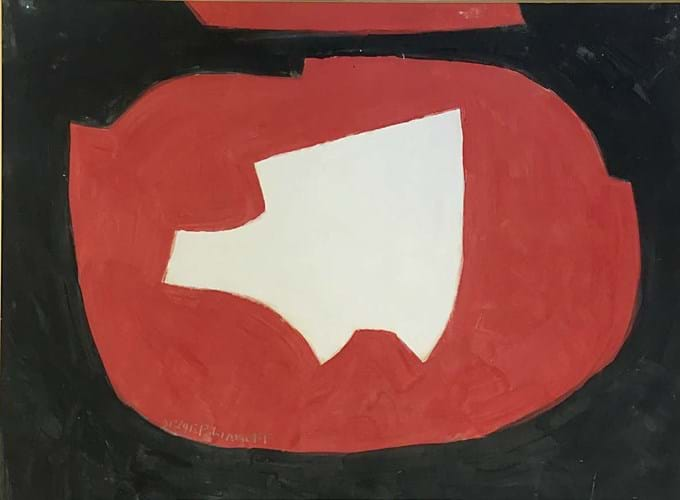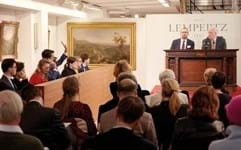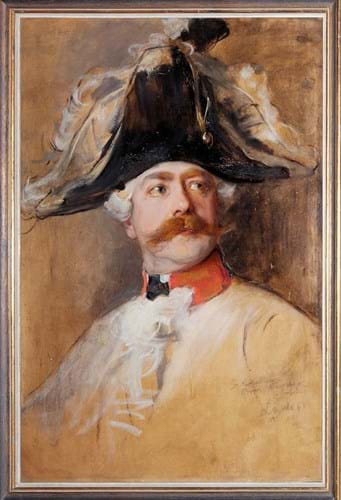
Heidelberg
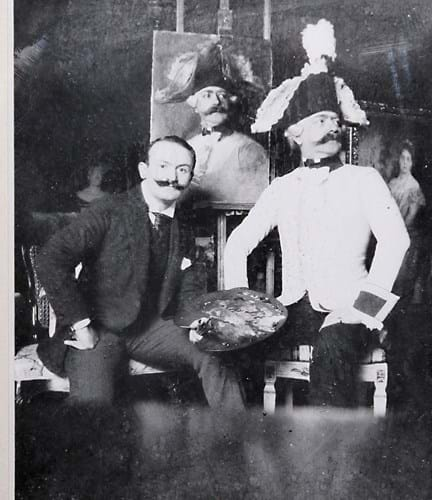
Philip de Lászlo’s portrait of Hugo von Reischach sold for €21,000 (£18,585) at Kunst & Kuriosa in Heidelberg. The accompanying photo of artist and sitter is shown here.
A central part of the sale at Kunst & Kuriosa (24.99% buyer’s premium) in Heidelberg on March 2 comprised the contents of Schloss Nussdorf in Baden Wurttemberg.
It was originally built in the 16th century, but was largely replaced in the 19th century with a new building in medieval style. Nussdorf was the long-time residence of the German aristocratic family Von Reischach.
Among the sought-after paintings was a Portrait of Hugo von Reischach, executed in 1899 by the Anglo-Hungarian portrait painter Philip Alexius de Lászlo (1869-1937).
The list of his sitters reads like a ‘Who’s Who’ of European royal houses and included the emperors of Austria and Germany, kings and queens of Greece, Spain, Romania and England (including the current monarch, when still a princess), not to mention several archbishops, a pope and the US President Calvin Coolidge.
Hugo von Reischach (1854-1934), the subject of the painting sold in Heidelberg, who posed for de Lászlo in historical ceremonial costume, was the Oberhofmarschall, the official in charge of the Imperial Court of Kaiser Wilhelm II.
On the reverse is an uncompleted oil sketch of the same subject. The signed and dated painting in oil on board, measuring 2ft 5in x 20in (73 x 50cm), was accompanied by several interesting documents, including a photo of artist and sitter proudly positioned in front of the painting.
The auctioneers underestimated the demand for the portrait, which rose from the reserve of €450 to its hammer price of €21,000 (£18,585), bid by a buyer from England.
Plauen
Bidders from all over the world struck the right note when Mehlis (20% buyer’s premium) in Plauen auctioned a wide selection of musical instruments from a private museum in its February 22-24 sale.
As all lots were offered without reserve, some dramatic price rises resulted. Top honours went to an early 19th century clavichord made by Gebrüder Kraemer in Göttingen, which sold for €12,000 (£10,620).
A late 18th century glass armonica (previewed in ATG No 2338, and also shown here) changed hands for €5000 (£4425), while an 18th century natural trumpet, signed by the well-known Nuremberg maker Johann Wilhelm Haas, found a new owner for €9000 (£7965).
Worthy of note in the general sale was the €16,000 (£14,160) for a 3ft 8in (1.1m) high Sitzmaschine (Seating Machine), designed by Josef Hoffmann for the Wiener Werkstätte in 1905.
The Austrian reclining chair with its adjustable back rest was manufactured by J&J Kohn in bentwood and stained plywood in various models, and stayed in production until 1916.
Cologne
Scale models of famous Italian monuments made from cork were particularly sought-after by the Grand Tourists of the 18th and 19th centuries. Among the most favoured subjects were Trajan’s Column, the Pyramid of Cestius and the Colosseum.
It was a model of the latter that was on offer at Van Ham (29/25% buyer’s premium) in Cologne on January 31 and caught the attention of numerous bidders.
Like many of its counterparts, it is remarkably finely executed, highly detailed and in general architecturally correct – although not exactly easy to transport as it measures 3ft 2in (97cm) in width. Although unsigned, it is considered to be the work of the Roman craftsman Luigi Carotti, about whom little is known, other than that he was active between 1839-54.
The catalogue guide of €3000-4000 proved too cautious. After a long bidding match an anonymous bidder secured the piece for €38,000 (£33,630).
Saarbruecken
Eagle-eyed bidders spotted a modestly estimated late 19th century silver jug in the March 7 auction at Dawo (20% buyer’s premium) in Saarbruecken.
The 7in (17cm) high vessel was chased, partly gilt and lavishly decorated in cloisonné enamel.
In two of the reserves on the side of the jug are depictions of the monumental Tsar Bell and the Triumphal Arch in Moscow.
The marks showed that it was the work of Ivan Khlebnikov, who had set up his own jewellery business in St Petersburg in 1865, following in his father’s footsteps.
Several years later he opened a factory for silverware and ornaments in Moscow where he received numerous commissions from the Imperial Court soon to be followed by orders from the ruling houses of Denmark, the Netherlands, Serbia and Montenegro.
By 1880 his company IP Khlebnikov employed 200 craftsmen.
The jug, which was on offer for €800, was dated 1880. It went on to sell for €11,000 (£9735), not surprisingly, to a Russian bidder.
Coburg
The Franco-Russian artist Serge Poliakoff (1900-69) was the star of the show at Richter & Kafitz (20% buyer’s premium) in Coburg on February 24.
A 20in x 2ft (50 x 65cm) signed abstract composition in black, red and white, in gouache on paper, was expected to bring €12,000. Its authenticity had been certified by the artist’s son, Alexis.
Having left his home country after the Russian Revolution, Poliakoff finally settled in Paris in 1923. At first he made his living as a musician, before devoting himself to art. Over the course of his career, he reduced his palette to very few colours.
This gouache was one of his last works, completed in 1968, one year before his death. Several French bidders on the phone were outpaced by their German competitor on another line, who won the day at €36,000 (£31,860).
Stuttgart

A 19th century carved wood and bone triptych in Gothic style – €32,000 (£28,320) at Nagel in Stuttgart.
Nagel (33% buyer’s premium) opened its auction season in Stuttgart on February 21 with a general sale.
Among the highlights was a highly intricate, late 19th century altar triptych in the Gothic style. It has been in the possession of a European noble family since its creation.
At the centre of the 2ft x 13in (61 x 33cm) composition of wood, carved, partly painted and gilt bone and iron, is the Descent from the Cross, flanked by scenes from the Life of Christ, the Four Evangelists and numerous other biblical figures, incorporating the coat of arms of the Kingdom of Aragon.
On account of the manner of the work and the materials used, Nagel attributed the triptych to the Spanish craftsman Francisco Pallás y Puig (1859-1926) in Valencia. He is well known for his intricate bone carvings, many of which appeared on the market in the early 20th century. The jury is still out as to whether his works were homages or just plain forgeries.
The bidders in Stuttgart were obviously impressed by the high standard of craftsmanship of this triptych, pushing the price from the estimated €5000 to €32,000 (£28,320), with a German collector emerging as the winner.
£1 = €1.1





